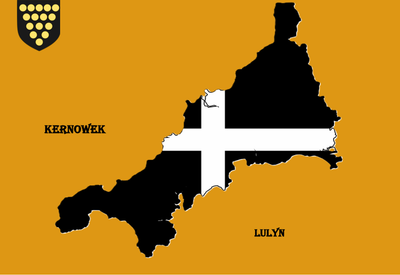Moy Adro Bos
Moy Adro Bos
Below is a table of “Bos” or “to be” in present tense with some examples of its use:
Of vy – I am (I be)
Os ta – you are / thou are (you be)
Yw ev – He is (he be)
Yw hy – She is (she be)
On ny – We are (we be)
Owgh why – We are (we be)
Yns y – They are (they be)
When using “Bos” in this form to make a statement or answer a question in the positive the verb will follow the object e.g.
Lowen ov vy – happy I be (I am happy)
Trist os ta – sad you be (You are sad)
Crev yw ev – strong he be (He is strong)
Teg yw hy – nice she be (She is nice)
Cowetha on ny – Friends we be (We are friends)
Pùscadoryon owgh why – Fishermen you be (You are fisherman)
Tus ha benenes yns y – Men and women they be (They are men and women
Note: it is useful when learning Kernowek to think of things in terms of “be” for example “I be” rather than “I am” as this will remind you that you should be using “Bos”.
By placing “Bos” before the object you create a question form rather than positive statement:
Os ta trist? – Be you sad? (Are you sad?)
Yw hy teg? – Be she nice? (Is she nice?)
Owgh why Pùscadoryon? – Be you fishermen? (Are you fishermen?)
You can also use “Bos” with personal pronouns:
Me – me
Te – you
Ev – he
Hy – she
Ny – we
Why – you
Y – they
Note: When you use verbs with personal pronouns you use only the “Third Person Singular” of the verb, even for plural subjects.
For example, some of the third person singulars of “Bos” are as listed below:
Yw – present (am)
O – past (was)
Vedh – future (will be)
There are other tenses of “Bos” but we will only use those above for this example. Remember the above rule applies when using any verbs with personal pronouns.
Examplys:
Me yw lowen – I am happy
Te o trist – You were sad
Ev a vedh crev – He will be strong
When you are comfortable with this construction you can create other types of questions using “Pёth” (What) and “Pyw” (Who) as below:
Remember as words in Kernowek are masculine (Gorow) or Female (Benow) “ev and hy” can not only refer to people but also things, depending on whether the thing in question is masculine or feminine, so can be “it”
Pёth yw ev? (What is He?) – Maw yw ev (He is a boy)
Pёth yw ev? (What is it?) – Lyver yw ev (It is a book)
Pёth yw hy? (What is she?) – Mowes yw hy (She is a girl)
Pёth yw hy? (What is it?) – Pluven yw hy (A pen it is)
Examplys:
Me yw lowen – I am happy
Te o trist – You were sad
Ev a vedh crev – He will be strong
When you are comfortable with this construction you can create other types of questions using “Pёth” (What) and “Pyw” (Who) as below:
Remember as words in Kernowek are masculine (Gorow) or Female (Benow) “ev and hy” can not only refer to people but also things, depending on whether the thing in question is masculine or feminine, so can be “it”
Pёth yw ev? (What is He?) – Maw yw ev (He is a boy)
Pёth yw ev? (What is it?) – Lyver yw ev (It is a book)
Pёth yw hy? (What is she?) – Mowes yw hy (She is a girl)
Pёth yw hy? (What is it?) – Pluven yw hy (A pen it is)
Pyw yw ev? (Who is he?) – Wella yw ev (He is Wella)
Pyw owgh why? (Who are you?) – Pùscadoryon on ny (Fishermen are we)
Remember when answering questions, it is necessary to change the person in some cases when answering for example “Who are you – pyw os ta?” should be answered “Peter I am – Pedr of vy”. This will also apply for “you” and “we” in the same way.
